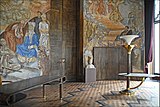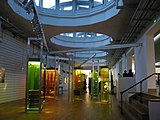Permanent Colonial Museum
The building was constructed for the Paris Colonial Exposition of 1931 to designs by French architect Albert Laprade, Léon Jaussely and Léon Bazin. It provides 16,000 m of exhibition and office space. External bas-reliefs (1200 m) by sculptor Alfred Janniot portray ships, oceans, and wildlife including antelopes, elephants, zebras, and snakes. The building's bas-reliefs and interior frescoes present an idealized version of colonialism that ignores colonialism's negative impacts. The building is considered a landmark of Art Deco architecture.
The Palais de la Porte Dorée has housed a succession of ethnological museums, starting with the colonial exhibition of 1931, which was renamed in 1935, the Musée de la France d'Outre-mer, then in 1960, the Musée des Arts africains et océaniens, and finally in 1990, the Musée national des Arts d'Afrique et d'Océanie. In 2003, these collections were merged into the Musée du quai Branly, and in its place the building now houses the Cité nationale de l'histoire de l'immigration. In January 2012, the Public Establishment of the Palais de la Porte Dorée (EPPPD) was officially created by decree. It brings together a historical monument, the Palais de la Porte Dorée, a museum, the National Museum of the History of Immigration and a tropical aquarium.
The building's cellar is home to the Dorée Tropical Aquarium (French: Aquarium du palais de la Porte Dorée), which contains about 5,000 animals representing 350 species in a variety of tanks ranging from 100 to 370,000 L (26 to 97,744 US gal) in size.
-
Marshal Lyautey's drawing room (Asia)
-
Forum (central court)
-
Paul Reynaud's drawing room (Africa)
See also
References
- ^ "The Bas-relief on the Facade of the Palais de la Porte Dorée | Palais de la Porte Dorée". www.palais-portedoree.fr. Retrieved 2021-06-30.
- ^ "The Forum Frescoes | Palais de la Porte Dorée". www.palais-portedoree.fr. Retrieved 2021-06-30.
- ^ Nayeri, Farah (2021-03-17). "In a Palace of Colonialism, a 'Quiet Revolutionary' Takes Charge". The New York Times. ISSN 0362-4331. Retrieved 2021-06-30.
- ^ "This Little-Known Paris Art Deco Landmark Inspired a Young Christian Louboutin". Architectural Digest. Retrieved 2021-06-30.
- ^ "The Architectural Style of the Palace | Palais de la Porte Dorée". www.palais-portedoree.fr. Retrieved 2021-06-30.
- ^ "Découvrir le monument | Monument du Palais de la Porte dorée". monument.palais-portedoree.fr (in French). Retrieved 2023-06-21.
- ^ "Musée de l'histoire de l'immigration | Palais de la Porte Dorée". www.histoire-immigration.fr. Retrieved 2023-06-21.







